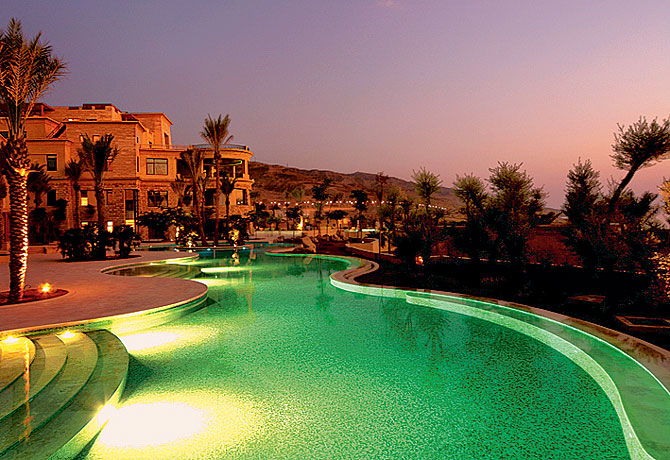
Dead Glamorous: The Kempinski Hotel Ishtar is one of a number of luxury properties bringing new life to Jordan's Dead Sea
Wedged precariously between Israel and Iraq, and lacking the oil riches of other countries in the region, the desert nation of Jordan appears to have received a raw deal. Little wonder, then, that it tries to exploit the resources it does have. One of these is the natural wonder of the Dead Sea. Located a 75-minute drive west of the capital Amman and 1,300 ft. (400 m) below sea level, Jordan's Dead Sea shores have traditionally been overlooked by travelers in favor of the far more developed Israeli side. Yet Jordan's under-the-radar status is actually its greatest appeal. In place of backpackers and charter crowds, Bedouin herdsman and the occasional Christian pilgrim are the most common visitors to the area — along with travelers en route to Jordan's most popular tourism spot, the lost "pink city" of Petra, two hours south.
These days, however, Jordan's sleepy stretch of Dead Sea coast is slowly awakening as a clutch of new hotels and spas emerge. As in Israel, Jordan's new resorts are making the most of thermal baths, therapeutic mud and mineral-rich waters. Yet unlike the facilities on the Israeli side, the Jordanian properties are almost uniformly five-star.
The most sensational is the 318-room Kempinski Hotel Ishtar, www.kempinski-deadsea.com, which began opening in phases in late 2006. Despite its stark desert location — surrounded by red-earth cliffs accented by the lights of Jerusalem in the distance — the Ishtar is dominated by water. A massive infinity-edge swimming pool (one of nine) graces the shorefront, and the Dead Sea's shimmering salty waves lie just steps away. A-list guests (actress Renee Zellweger has been spotted among them) are already being lured, and they will likely want to return once the resort's expanded Anantara Spa finally debuts this year. One of the largest in the Middle East, it will span 108,000 sq. ft. (10,000 sq m) and include 20 treatment rooms, an ice cave, a hammam and 28 spa-themed guest suites.
The new Six Senses Spa at the Janna Spa and Resort, www.jannaspa.com, is a little more modest, but lying deep in the Moab Hills — about 30 minutes east of the Dead Sea — it is set amid marvelous history. In Biblical legend, this was where Moses was said to have taken his first (and last) look at the Promised Land, and where King Herod sought solace in healing baths. Today, those thermal baths supposedly form the core of the Janna — a onetime government-owned three-star facility, recently overhauled by Saudi investors.
Back at the Dead Sea itself, two of the area's original resorts — the Jordan Valley Marriott Resort & Spa, www.marriott.com, and the Mövenpick Resort & Spa, www.moevenpick-hotels.com — are introducing fresh amenities and treatments (such as the Marriott's Arabic coffee scrub) to keep up with their new neighbors. But with cranes looming in the distance, it's plain that the Kempinski and Janna won't be the area's most recent arrivals for long. A new Crowne Plaza and Holiday Inn will open next year, while Dubai-based Emaar is spearheading a $500 million resort cum residential project close to the Kempinski. The massive new Al Hussein Convention Center continues to rise just down the coast.
Development is being controlled by King Abdullah II, so despite the rash of new building the hope is that Jordan's Dead Sea shores won't ever resemble the ancient cities of Sodom and Gomorrah, which once flourished nearby. Far more worrying, however, is the Dead Sea itself. It is disappearing at a rate of about three feet per year because the River Jordan, which feeds it, is being overused for domestic and agricultural purposes by Jordan, Israel and Syria. Scientists say the sea is secure until at least 2050. That may be time to get in a few mud scrubs, but what will become of all these hotels when the water disappears is another matter.